check engine light BMW Z3 2002 Owners Manual
[x] Cancel search | Manufacturer: BMW, Model Year: 2002, Model line: Z3, Model: BMW Z3 2002Pages: 187, PDF Size: 2.73 MB
Page 20 of 187
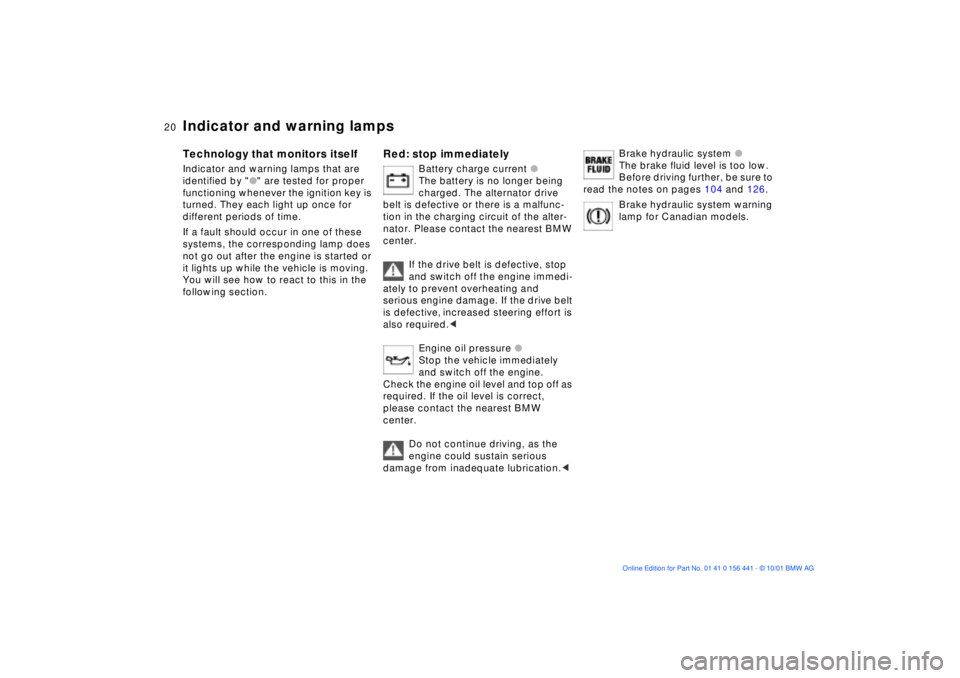
20n
Indicator and warning lamps
Technology that monitors itself
Indicator and warning lamps that are
identified by "
l
" are tested for proper
functioning whenever the ignition key is
turned. They each light up once for
different periods of time.
If a fault should occur in one of these
systems, the corresponding lamp does
not go out after the engine is started or
it lights up while the vehicle is moving.
You will see how to react to this in the
following section.
Red: stop immediately
Battery charge current
l
The battery is no longer being
charged. The alternator drive
belt is defective or there is a malfunc-
tion in the charging circuit of the alter-
nator. Please contact the nearest BMW
center.
If the drive belt is defective, stop
and switch off the engine immedi-
ately to prevent overheating and
serious engine damage. If the drive belt
is defective, increased steering effort is
also required.
<
Engine oil pressure
l
Stop the vehicle immediately
and switch off the engine.
Check the engine oil level and top off as
required. If the oil level is correct,
please contact the nearest BMW
center.
Do not continue driving, as the
engine could sustain serious
damage from inadequate lubrication.
<
Brake hydraulic system
l
The brake fluid level is too low.
Before driving further, be sure to
read the notes on pages 104 and 126.
Brake hydraulic system warning
lamp for Canadian models.
Page 103 of 187
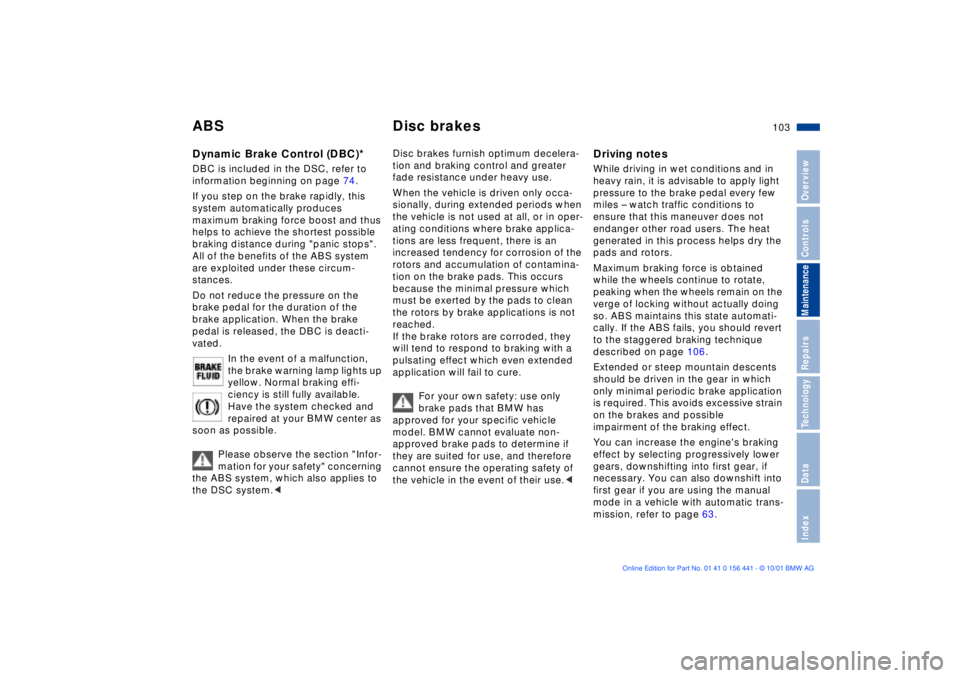
103n
IndexDataTechnologyRepairsMaintenanceControlsOverview
ABS Disc brakesDynamic Brake Control (DBC)*DBC is included in the DSC, refer to
information beginning on page 74.
If you step on the brake rapidly, this
system automatically produces
maximum braking force boost and thus
helps to achieve the shortest possible
braking distance during "panic stops".
All of the benefits of the ABS system
are exploited under these circum-
stances.
Do not reduce the pressure on the
brake pedal for the duration of the
brake application. When the brake
pedal is released, the DBC is deacti-
vated.
In the event of a malfunction,
the brake warning lamp lights up
yellow. Normal braking effi-
ciency is still fully available.
Have the system checked and
repaired at your BMW center as
soon as possible.
Please observe the section "Infor-
mation for your safety" concerning
the ABS system, which also applies to
the DSC system.<
Disc brakes furnish optimum decelera-
tion and braking control and greater
fade resistance under heavy use.
When the vehicle is driven only occa-
sionally, during extended periods when
the vehicle is not used at all, or in oper-
ating conditions where brake applica-
tions are less frequent, there is an
increased tendency for corrosion of the
rotors and accumulation of contamina-
tion on the brake pads. This occurs
because the minimal pressure which
must be exerted by the pads to clean
the rotors by brake applications is not
reached.
If the brake rotors are corroded, they
will tend to respond to braking with a
pulsating effect which even extended
application will fail to cure.
For your own safety: use only
brake pads that BMW has
approved for your specific vehicle
model. BMW cannot evaluate non-
approved brake pads to determine if
they are suited for use, and therefore
cannot ensure the operating safety of
the vehicle in the event of their use.<
Driving notesWhile driving in wet conditions and in
heavy rain, it is advisable to apply light
pressure to the brake pedal every few
miles Ð watch traffic conditions to
ensure that this maneuver does not
endanger other road users. The heat
generated in this process helps dry the
pads and rotors.
Maximum braking force is obtained
while the wheels continue to rotate,
peaking when the wheels remain on the
verge of locking without actually doing
so. ABS maintains this state automati-
cally. If the ABS fails, you should revert
to the staggered braking technique
described on page 106.
Extended or steep mountain descents
should be driven in the gear in which
only minimal periodic brake application
is required. This avoids excessive strain
on the brakes and possible
impairment of the braking effect.
You can increase the engine's braking
effect by selecting progressively lower
gears, downshifting into first gear, if
necessary. You can also downshift into
first gear if you are using the manual
mode in a vehicle with automatic trans-
mission, refer to page 63.
Page 133 of 187
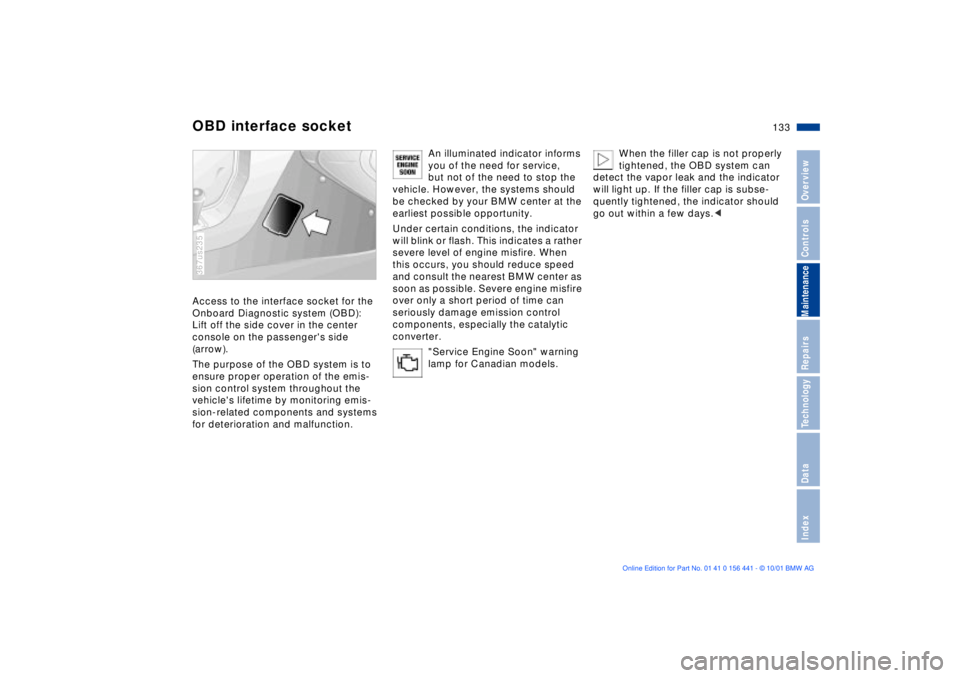
133n
IndexDataTechnologyRepairsMaintenanceControlsOverview
OBD interface socketAccess to the interface socket for the
Onboard Diagnostic system (OBD):
Lift off the side cover in the center
console on the passenger's side
(arrow).
The purpose of the OBD system is to
ensure proper operation of the emis-
sion control system throughout the
vehicle's lifetime by monitoring emis-
sion-related components and systems
for deterioration and malfunction.367us235
An illuminated indicator informs
you of the need for service,
but not of the need to stop the
vehicle. However, the systems should
be checked by your BMW center at the
earliest possible opportunity.
Under certain conditions, the indicator
will blink or flash. This indicates a rather
severe level of engine misfire. When
this occurs, you should reduce speed
and consult the nearest BMW center as
soon as possible. Severe engine misfire
over only a short period of time can
seriously damage emission control
components, especially the catalytic
converter.
"Service Engine Soon" warning
lamp for Canadian models.
When the filler cap is not properly
tightened, the OBD system can
detect the vapor leak and the indicator
will light up. If the filler cap is subse-
quently tightened, the indicator should
go out within a few days.<
Page 179 of 187
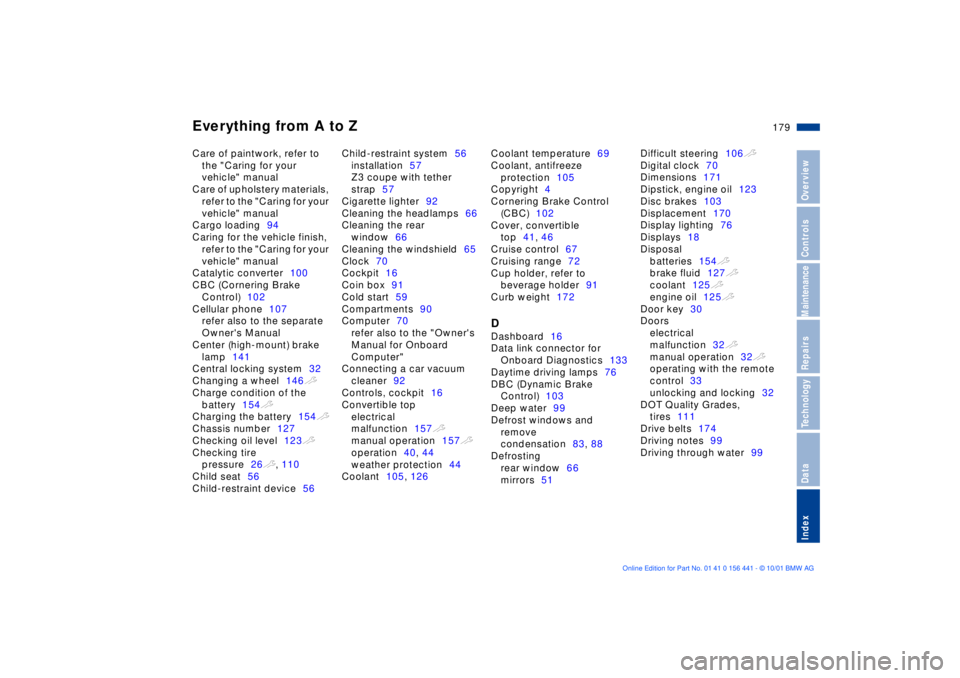
Everything from A to Z
179n
IndexDataTechnologyRepairsMaintenanceControlsOverview
Care of paintwork, refer to
the "Caring for your
vehicle" manual
Care of upholstery materials,
refer to the "Caring for your
vehicle" manual
Cargo loading94
Caring for the vehicle finish,
refer to the "Caring for your
vehicle" manual
Catalytic converter100
CBC (Cornering Brake
Control)102
Cellular phone107
refer also to the separate
Owner's Manual
Center (high-mount) brake
lamp141
Central locking system32
Changing a wheel146t
Charge condition of the
battery154t
Charging the battery154t
Chassis number127
Checking oil level123t
Checking tire
pressure26t, 110
Child seat56
Child-restraint device56Child-restraint system56
installation57
Z3 coupe with tether
strap57
Cigarette lighter92
Cleaning the headlamps66
Cleaning the rear
window66
Cleaning the windshield65
Clock70
Cockpit16
Coin box91
Cold start59
Compartments90
Computer70
refer also to the "Owner's
Manual for Onboard
Computer"
Connecting a car vacuum
cleaner92
Controls, cockpit16
Convertible top
electrical
malfunction157t
manual operation157t
operation40, 44
weather protection44
Coolant105, 126Coolant temperature69
Coolant, antifreeze
protection105
Copyright4
Cornering Brake Control
(CBC)102
Cover, convertible
top41, 46
Cruise control67
Cruising range72
Cup holder, refer to
beverage holder91
Curb weight172
DDashboard16
Data link connector for
Onboard Diagnostics133
Daytime driving lamps76
DBC (Dynamic Brake
Control)103
Deep water99
Defrost windows and
remove
condensation83, 88
Defrosting
rear window66
mirrors51Difficult steering106t
Digital clock70
Dimensions171
Dipstick, engine oil123
Disc brakes103
Displacement170
Display lighting76
Displays18
Disposal
batteries154t
brake fluid127t
coolant125t
engine oil125t
Door key30
Doors
electrical
malfunction32t
manual operation32t
operating with the remote
control33
unlocking and locking32
DOT Quality Grades,
tires111
Drive belts174
Driving notes99
Driving through water99
Page 183 of 187
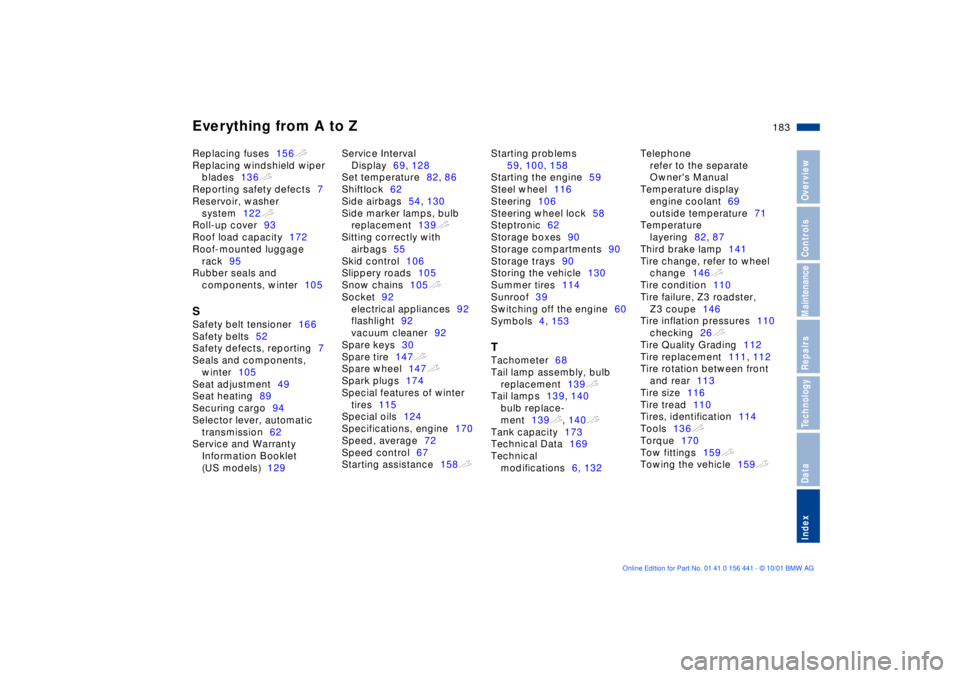
Everything from A to Z
183n
IndexDataTechnologyRepairsMaintenanceControlsOverview
Replacing fuses156t
Replacing windshield wiper
blades136t
Reporting safety defects7
Reservoir, washer
system122t
Roll-up cover93
Roof load capacity172
Roof-mounted luggage
rack95
Rubber seals and
components, winter105SSafety belt tensioner166
Safety belts52
Safety defects, reporting7
Seals and components,
winter105
Seat adjustment49
Seat heating89
Securing cargo94
Selector lever, automatic
transmission62
Service and Warranty
Information Booklet
(US models)129Service Interval
Display69, 128
Set temperature82, 86
Shiftlock62
Side airbags54, 130
Side marker lamps, bulb
replacement139t
Sitting correctly with
airbags55
Skid control106
Slippery roads105
Snow chains105t
Socket92
electrical appliances92
flashlight92
vacuum cleaner92
Spare keys30
Spare tire147t
Spare wheel147t
Spark plugs174
Special features of winter
tires115
Special oils124
Specifications, engine170
Speed, average72
Speed control67
Starting assistance158tStarting problems
59, 100, 158
Starting the engine59
Steel wheel116
Steering106
Steering wheel lock58
Steptronic62
Storage boxes90
Storage compartments90
Storage trays90
Storing the vehicle130
Summer tires114
Sunroof39
Switching off the engine60
Symbols4, 153
TTachometer68
Tail lamp assembly, bulb
replacement139t
Tail lamps139, 140
bulb replace-
ment139t, 140t
Tank capacity173
Technical Data169
Technical
modifications6, 132Telephone
refer to the separate
Owner's Manual
Temperature display
engine coolant69
outside temperature71
Temperature
layering82, 87
Third brake lamp141
Tire change, refer to wheel
change146t
Tire condition110
Tire failure, Z3 roadster,
Z3 coupe146
Tire inflation pressures110
checking26t
Tire Quality Grading112
Tire replacement111, 112
Tire rotation between front
and rear113
Tire size116
Tire tread110
Tires, identification114
Tools136t
Torque170
Tow fittings159t
Towing the vehicle159t